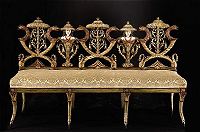 click to enlarge |
SUITE OF FANTASTICALLY CARVED FURNITUREMichaelangelo Pergolesi SN 1533, 1770-1801 carved wood, polychromed From "The Pages"
|
ARTIST:
Pergolesi was a designer/architect from Venice who worked in London for Robert Adam, an architect and interior designer. Pergolesi published Designs for Various Ornaments (pillars, paneling, and scrollwork) for use by architects. Both men influenced English Regency and French Louis XVI styles, using classical motifs from ancient and Renaissance Italian sources. Very little is known of his personal life.
FURNITURE:
The suite consists of two settees and two chairs, fantastically carved in Neoclassical style, done after 1770. It was purchased through the A. Everett Austin Fund in 1949.
All the pieces have openwork backrests, lending them a light, elegant, graceful feeling. Heads of real people and birds are creatively combined with imaginary flowers and leaves. Parasols become hats, empty spaces are filled with fan forms, and swags of red beads connect the elements. The legs are delicate, topped with acanthus leaves and rosettes, and culminating in animal hooves. The upholstery is not original.
Symmetry and repetition break from the Rococo style of asymmetry, to satisfy the Neoclassical taste. The wood is polychromed in colors that would unite it with the room’s decor. This furniture is reputed to have been imported by the Misses Cooper, and other elements of the suite are in the Cooper-Hewitt and Metropolitan Museum collections in New York. The carved wood is polychromed over gesso.
HISTORIC CONTEXT:
In the late 18th c, taste changed from the Rococo’s light-hearted style to Neoclassical with its order, clarity, and reason….the intent being to reflect the heroic spirit of the times. The movement was spearheaded by the archeologist/art historian Johann Winklemann’s excavations at Pompeii and Herculaneum. There was great appeal in the classic Roman strong moral values and social/civic life. The work of Winklemann, centered in Rome, touched the careers of many Europeans who visited that city.
Robert Adam restored or imitated Roman baths and villas, applying Roman motifs to interiors and furniture. He published works on the subject. In addition to Pergolesi, Angelica Kauffman and her husband Zucchi were also suppliers. The “grotesque” style made use of natural forms – but redistributed them in playful ways according to the fancy of the artist. The grotteschi were occasionally used by the Classicists Piranesi and Adam in the context of the Neoclassical movement in the decorative arts. [Grotesque is a term designating a type of Roman decoration which combined life and art in an incongruous manner.]